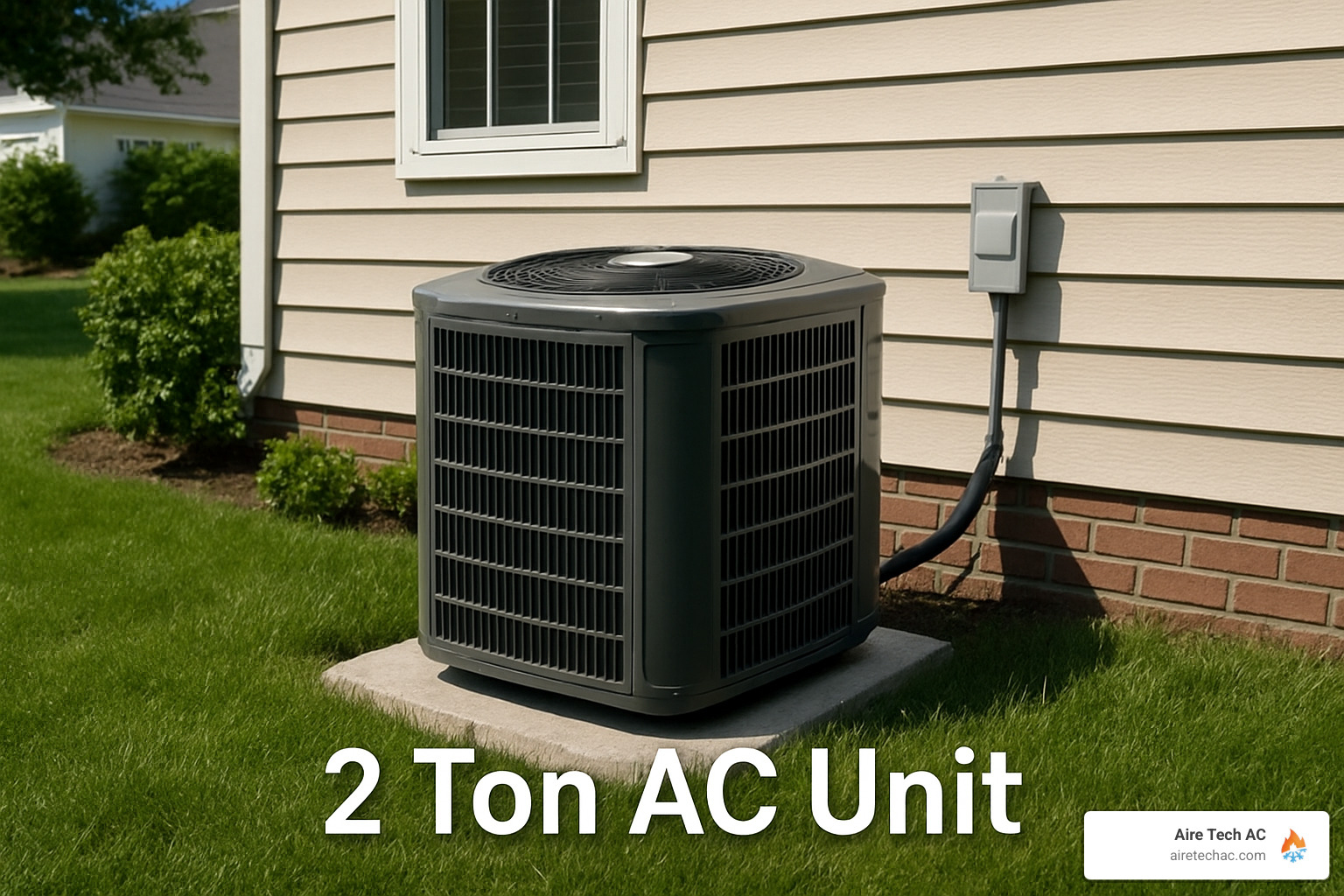Understanding AC Tonnage: What Size Do You Need?
Choosing the right air conditioning unit involves more than just picking a brand or model. The tonnage of an AC unit—whether 2 ton, 3 ton, or 5 ton—directly affects its cooling power and efficiency. These ratings indicate how much heat the unit can remove from a space in one hour, with higher tonnage suited for larger or more demanding environments. However, bigger is not always better. An oversized unit can lead to short cycling, uneven cooling, and increased energy costs, while an undersized system may struggle to maintain comfortable temperatures.
The term “ton” in air conditioning doesn’t refer to weight but instead to cooling power. It originated from the cooling effect of melting one ton of ice in 24 hours. Today, one AC “ton” equals 12,000 BTUs of cooling capacity per hour.
A 2 ton unit is typically ideal for smaller homes or individual zones within a larger building. A 3 ton system works well for mid-sized homes or moderate open-plan spaces, offering a balance of power and efficiency. For large homes, commercial spaces, or areas with high heat loads, a 5 ton unit may be necessary to ensure consistent comfort. Understanding the unique demands of your space—including insulation quality, ceiling height, and sun exposure—is critical to selecting the most appropriate system. Making an informed choice helps ensure reliable cooling performance and long-term cost savings.
Quick AC Unit Size Guide:
- 2 ton AC unit: 24,000 BTU, cools 1,000-1,400 sq ft
- 3 ton AC unit: 36,000 BTU, cools 1,500-2,000 sq ft
- 5 ton AC unit: 60,000 BTU, cools 2,600-3,200 sq ft
Choosing the right AC size is crucial for both comfort and efficiency. An undersized unit will run constantly and struggle to cool your home, while an oversized unit will cycle on and off too frequently, causing temperature swings and humidity issues.
When selecting an AC unit, consider:
- Square footage of your home
- Climate in your region
- Insulation quality
- Window size and count
- Ceiling height
- Sun exposure
The cost of a 2 ton AC unit typically ranges from $2,800 to $7,300 installed, with an average of about $5,250 including parts and labor. Higher efficiency models (with SEER ratings from 14-20) cost more upfront but save money on energy bills over time.
Proper installation by qualified professionals is just as important as choosing the right size unit. A correctly sized and properly installed 2 ton AC system will provide years of efficient, reliable cooling comfort.
2 Ton AC Unit: Specs, Coverage & Best Uses
When it comes to home cooling solutions, the 2 ton AC unit hits a sweet spot that many homeowners love. With 24,000 BTUs of cooling power, these systems provide that “just right” balance between cooling capacity and energy efficiency for medium-sized homes.
Here in Southern California, the 2 ton AC unit is one of our most frequently installed systems. Our Aire Tech AC technicians are constantly setting up these reliable cooling systems in homes across Riverside, Perris, and Temecula, where they perform beautifully in our moderate climate.
Let’s look at how a 2 ton AC unit stacks up against larger systems:
| Specification | 2 Ton AC | 3 Ton AC | 5 Ton AC |
|---|---|---|---|
| BTU Capacity | 24,000 BTU | 36,000 BTU | 60,000 BTU |
| Recommended Square Footage | 1,000-1,400 sq ft | 1,500-2,000 sq ft | 2,600-3,200 sq ft |
| Typical SEER Range | 14-20 | 14-20 | 14-18 |
| Average Power Consumption | 1,000-3,000 watts | 3,000-3,500 watts | 5,000-6,000 watts |
| Typical Starting Cost | $2,800 | $3,500 | $4,300 |
| Annual Operating Cost* | $300-$600 | $450-$750 | $750-$1,200 |
*Operating costs vary based on local electricity rates, usage patterns, and unit efficiency
Today’s 2 ton AC units typically use R-410A refrigerant, which is much kinder to the environment than the older R-22 refrigerant. When shopping for your system, you’ll need to choose between single-stage and two-stage compressors. The two-stage models cost more upfront but provide better temperature control and efficiency that you’ll appreciate during those hot California summers.
Want to explore complete cooling solutions including 2 ton AC units? Visit our Central Air Conditioner page to learn more about our installation services.
How many square feet can a 2 ton ac unit cool?
A 2 ton AC unit typically cools between 1,000 and 1,400 square feet of living space under normal conditions. This follows the general HVAC rule of thumb that you need about one ton of cooling capacity for every 500-700 square feet of home.
However, this isn’t a one-size-fits-all formula. Several important factors affect how much space your 2 ton AC unit can effectively cool:
Your climate zone makes a big difference. Here in Perris and Riverside, our inland heat means you might need more cooling power than homes in breezier coastal areas. Well-insulated homes with modern windows might allow a 2 ton AC unit to cool up to 1,500 square feet effectively, while homes with vaulted ceilings need more capacity because there’s simply more air to cool.
Sun exposure plays a huge role too – those beautiful west-facing windows that give you gorgeous sunset views also bring in substantial heat. And your home’s layout matters – open floor plans typically cool more efficiently than homes with many separate rooms.
We’ve installed 2 ton AC units in countless different home configurations throughout our service areas. Just last month, we set up a perfectly-sized 2-ton system in a well-insulated 1,300 square foot ranch-style home in Menifee. Meanwhile, a similarly sized home with older windows in hotter Cathedral City needed a 2.5-ton unit to keep the family comfortable.
Key features & specifications
When you’re considering a 2 ton AC unit for your home, several important specifications deserve your attention:
Most 2 ton AC units run on standard 208/230 volt electrical service. This is typical residential power, but it’s always smart to have your Aire Tech AC professional verify that your home’s electrical panel can handle the load, especially if you’re upgrading from window units or an older system.
SEER and SEER2 ratings are crucial for understanding efficiency. Higher numbers mean greater efficiency and lower operating costs. Recent regulations introduced SEER2 ratings, which use more realistic testing conditions. For 2 ton AC units, you’ll typically find minimum efficiency models at 14 SEER/13.4 SEER2, mid-range units at 16 SEER/15.2 SEER2, and high-efficiency models at 18-20+ SEER/17.2-19+ SEER2.
Modern 2 ton AC units use R-410A refrigerant, which is much better for the environment than older types. Some cutting-edge models are starting to use R-32, which has an even smaller environmental footprint.
Noise levels matter too, especially if your outdoor unit will be near a bedroom or patio. Outdoor condensers for 2 ton AC systems typically run at 70-75 decibels, though premium models can operate as quietly as 55-65 decibels. Inside your home, the air handler usually produces between 25-45 decibels depending on the model and fan speed.
Compressor technology significantly affects both comfort and operating costs. Single-stage compressors run at full blast whenever they’re on, while two-stage models can run at about 70% capacity on milder days, improving both efficiency and comfort. Variable-speed compressors offer the best performance by adjusting output precisely to match your needs, though they come with a higher price tag.
Quality 2 ton AC units also feature durable cabinets with corrosion-resistant finishes (especially important in our Southern California climate), composite base pans to reduce noise and prevent rust, and louvered panels that protect the coil while ensuring proper airflow.
From our experience serving communities across Riverside County, we’ve found that our customers particularly value quieter operation and higher efficiency ratings, especially as electricity rates continue to climb. Our team at Aire Tech AC is always happy to help you steer these options to find the perfect 2 ton AC unit for your specific needs.
3 Ton vs 5 Ton AC Units: Bigger Capacity Compared
When your home needs more cooling power than a 2 ton AC unit can provide, it’s time to consider the heavy hitters of residential air conditioning: 3-ton and 5-ton systems. These larger units pack a serious cooling punch, delivering 36,000 BTU and 60,000 BTU respectively – enough to tame the hottest Southern California summers in larger homes.

Moving up from a 2 ton AC unit isn’t just about getting more cooling – it’s like upgrading from a compact car to an SUV or truck. There’s more to consider than just the extra muscle.
For starters, these bigger systems need more air movement. While a 2 ton AC unit typically moves about 800 cubic feet of air per minute, a 5-ton system pushes around 2,000 CFM. That’s a lot more air flowing through your home!
Your electric bill will notice the difference too. Where a 2 ton AC unit might draw 1,000-3,000 watts during operation, a 3-ton system typically pulls 3,000-3,500 watts, and a 5-ton unit can draw a substantial 5,000-6,000 watts. This is why proper sizing matters so much for your comfort and your wallet.
You’ll also need more physical space for the outdoor unit. A 5-ton condenser can take up to 60% more space than its 2-ton little brother – something to consider if you have limited outdoor space.
One benefit of larger systems, especially those with multi-speed or variable-speed compressors, is their superior humidity control in bigger spaces. They can keep your home not just cool, but comfortably dry too.
“Many homeowners think bigger is better,” says our service manager at Aire Tech AC, “but an oversized system is like having a sports car that you can only drive in first gear. It uses more energy and provides less comfort.”
This is why proper load calculation becomes even more crucial with larger systems. The consequences of oversizing get more severe as tonnage increases, leading to higher energy bills, poor humidity control, frequent system cycling, and shorter equipment lifespan.
When to choose a 3-ton system
A 3-ton air conditioning system shines in several specific scenarios where a 2 ton AC unit just wouldn’t cut it:
Two-Story Homes present unique cooling challenges due to the “stack effect” – the natural tendency of warm air to rise. For two-story homes between 1,500-2,000 square feet, especially in toasty inland areas like Riverside or Perris, a 3-ton system often provides the right balance of cooling power.
Homes with Vaulted Ceilings need extra consideration too. When your ceilings soar beyond the standard 8-9 feet, you’ve got more air volume to cool. That charming architectural feature might bump you from a 2 ton AC unit to a 3-ton system.
If your home has Moderate to Poor Insulation – common in older homes with less efficient windows – you might need the extra oomph of a 3-ton system, even if your square footage suggests a 2 ton AC unit would work.
Medium-Sized Open Floor Plans between 1,500-2,000 square feet typically cool more effectively with a 3-ton system due to the larger continuous air volume with fewer walls to separate and contain the cooled air.
When a 5-ton unit makes sense
A 5-ton air conditioning system is the heavyweight champion of residential cooling, pumping out a mighty 60,000 BTUs. This is serious cooling power that goes far beyond what a 2 ton AC unit can handle, and it’s the right choice in specific situations:
Larger Homes between 2,600-3,200 square feet typically need this level of cooling capacity, especially in the scorching inland communities we serve like Perris, Riverside, and San Bernardino, where summer temperatures regularly climb above 100°F.
Homes with Extreme Climate Exposure may need a 5-ton system even if their square footage might suggest a smaller unit in a milder climate. When you’re battling triple-digit temperatures for months at a time, that extra cooling capacity becomes essential for comfort.
Certain Significant Heat-Gain Factors can push your cooling needs into 5-ton territory. These include extensive west or south-facing windows that let in afternoon sun, dark-colored roofing that absorbs heat like a sponge, minimal tree coverage or natural shade, sprawling great rooms with high ceilings, and homes filled with heat-generating appliances or electronics.
Some Multi-Family Applications benefit from a single 5-ton system serving multiple living spaces, like a main house with an attached guest house or in-law suite.
Sometimes, two smaller units (like twin 2.5-ton systems) might work better than a single 5-ton behemoth, especially in two-story homes or properties with distinct zones that have different cooling needs. This approach can provide more balanced cooling and better temperature control throughout your home.
Sizing, Efficiency & Cost Breakdown
Finding the perfect air conditioner size for your home is like shopping for shoes – too small and you’ll be uncomfortable, too large and you’ll waste money. While square footage guidelines give you a starting point, nothing beats a professional Manual J load calculation for determining whether that 2 ton AC unit is right for your home.
When our technicians at Aire Tech AC perform a Manual J calculation, they examine every factor that affects your home’s cooling needs: the exact dimensions, insulation values, window types, air leakage, heat-generating appliances, number of people living there, and even your local climate patterns.
We’ve noticed something interesting across our service areas – homes in Riverside and San Bernardino typically need more cooling power per square foot than similar-sized homes in coastal areas like Costa Mesa. Those hot inland temperatures really make a difference!
As a general guideline for Southern California homes, we typically see these sizing patterns:
- 600-900 sq ft: 1.5 ton
- 1,000-1,400 sq ft: 2 ton AC unit
- 1,500-2,000 sq ft: 3 ton
- 2,100-2,500 sq ft: 4 ton
- 2,600-3,200 sq ft: 5 ton
Want to learn more about efficiency ratings and how they affect your monthly bills? Check out our guides on What is a Good SEER Rating for Air Conditioners? and AC Efficiency Tips That Could Save You Money.
Understanding SEER & energy labels
SEER ratings can seem like alphabet soup, but they’re actually pretty simple – think of them as the MPG rating for your air conditioner. The higher the SEER (Seasonal Energy Efficiency Ratio), the more cooling you get for each dollar of electricity.
In 2023, the Department of Energy updated their testing procedures to create the new SEER2 standard. These new ratings are typically about 4.5% lower than the old SEER ratings because they use more realistic testing conditions – kind of like how real-world gas mileage usually differs from the sticker on a new car.
For a 2 ton AC unit, here’s what those efficiency numbers mean in plain English:
A 14 SEER/13.4 SEER2 unit is the minimum legal efficiency in Southern California. It’s like buying a basic sedan – it’ll get you where you’re going without any frills, at the lowest upfront cost.
A 16 SEER/15.2 SEER2 unit is your mid-range option that balances initial cost with energy savings. Many of our customers find this is the “sweet spot” of value – like choosing a well-equipped midsize car with some nice features but not going for the luxury package.
An 18-20+ SEER/17.2-19+ SEER2 unit is the premium choice. These high-efficiency models cost more upfront but deliver significant energy savings, especially in hot areas like Perris where your AC might run eight months a year. It’s like investing in a hybrid vehicle – more expensive initially, but the savings add up over time.
Variable-speed technology is where efficiency really shines. Unlike basic units that operate like an on/off switch, variable-speed compressors are more like a dimmer – they can run at precisely the level needed. This means better temperature control, improved humidity management, quieter operation, maximum efficiency, and a longer system life.
In our experience at Aire Tech AC, upgrading from a 14 SEER to an 18 SEER 2 ton AC unit typically saves our Southern California customers about $150-$300 annually on cooling costs. The exact savings depend on your usage patterns and local electricity rates, which we’ll be happy to calculate for your specific situation.
Call Aire Tech Today!
Finding the perfect cooling solution for your home isn’t just about comfort—it’s an investment in your daily quality of life and your home’s energy efficiency. Throughout this guide, we’ve explored how a 2 ton AC unit might be the ideal choice for many homes, while others may benefit from the additional power of 3-ton or 5-ton systems.
The right-sized air conditioner creates that perfect “Goldilocks zone” of comfort—not too cold, not too warm, with balanced humidity and consistent temperatures throughout your home. When your system is properly matched to your space, you’ll enjoy lower energy bills, better comfort, and a system that lasts years longer.
A 2 ton AC unit typically cools homes between 1,000-1,400 square feet effectively, but this can vary dramatically based on your home’s insulation, window quality, ceiling height, and local climate. Here in Southern California, where we experience everything from mild coastal conditions to scorching inland temperatures, having the right-sized system makes all the difference during those summer heatwaves.
Perhaps the most valuable takeaway is this: professional sizing through a Manual J load calculation isn’t an extra step—it’s an essential one. Think of it as getting a custom-custom suit instead of something off the rack. When your cooling system fits your home perfectly, you’ll feel the difference every day.
High-efficiency models with better SEER ratings might cost more initially, but they’re like choosing a fuel-efficient car. The savings add up month after month, especially during our long cooling seasons. Many of our customers tell us they wish they’d upgraded to a higher-efficiency model sooner after seeing their reduced utility bills.
At Aire Tech AC, we take pride in helping homeowners throughout Riverside, Perris, and surrounding communities find their perfect cooling match. We’re not just installing equipment—we’re creating comfortable environments where families thrive.
When you’re ready to explore whether a 2 ton AC unit or another size is right for your home, our team is here to provide honest, expert guidance. We’ll take the time to understand your specific needs, perform proper load calculations, and help you make an informed decision that you’ll be happy with for years to come.
For comprehensive support throughout your HVAC system’s lifetime, from installation to maintenance and eventual replacement, visit our page on More info about full-service HVAC support.
As your neighbors and Southern California’s trusted HVAC partner, Aire Tech AC is committed to keeping your home comfortable through every season—because when it comes to your family’s comfort, “good enough” just isn’t good enough.







